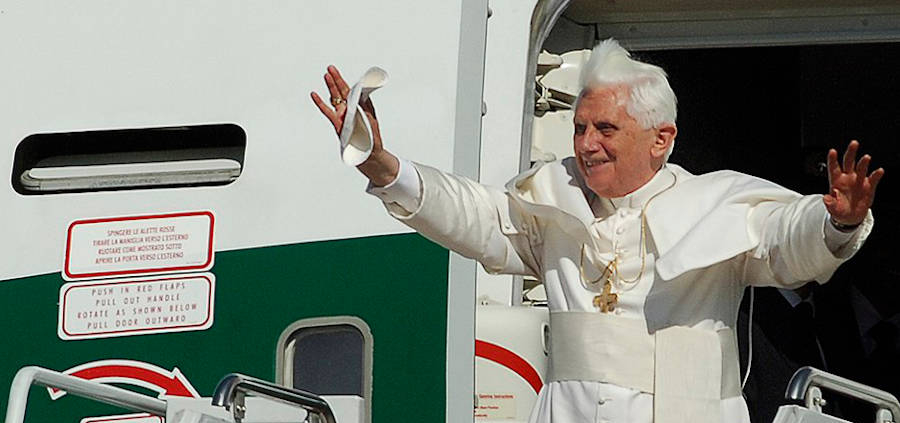Papal Doctrine by Julie A. Ferraro
 As a journalist for over 30 years, I’ve made a point to stand by the concepts of truth and integrity, as well as freedom of speech. I’ve resigned from newspapers where the owners were more concerned with the income from advertisers than reporting the honest news.
As a journalist for over 30 years, I’ve made a point to stand by the concepts of truth and integrity, as well as freedom of speech. I’ve resigned from newspapers where the owners were more concerned with the income from advertisers than reporting the honest news.
With the death on December 31 of Pope Emeritus Benedict XVI, an era of journalistic and theological suppression has come to an end—thankfully. Too many are the stories of how Joseph Ratzinger, even prior to being elected pope, attempted to silence those who spoke in opposition to his viewpoint or his tactics as head of the Congregation for the Doctrine of the Faith—among them, priests, sisters, and laypeople.
Back in 2005, when the news broke about Benedict XVI’s election as pope, I joked how the ideal headline would be, “Oh, Ratz!” Almost immediately after that, the hammer dropped on all those who still hoped the reforms of Vatican II would be revived after years of regression.
Notably, the investigation Benedict XVI sanctioned of American women’s religious communities and the Leadership Conference of Women Religious proved he could, and would, make certain such rebellious females would not step out of line—his line. Anyone who claims Benedict XVI was not guided by misogynistic ideals, believing women had no capacity to offer insights into faith and theology, is just flat wrong.
Benedict XVI’s death prompted thousands to file through St. Peter’s Basilica to pay their respects prior to his funeral. Comments from church leaders and diplomats filled websites and columns of print with praise of his holiness, brilliance, and for being a creative Catholic theologian, as George Weigel phrased it. He has been posthumously deemed “a good shepherd,” and noted for his humility.
Others have called Benedict XVI “God’s Rottweiler.” Jesuit Thomas Reese, the former editor of America magazine, frankly recalled his interactions with Ratzinger, before and after his election as Supreme Pontiff, noting how he was “silenced” after publishing articles in direct opposition to Ratzinger’s policies in the magazine.
Then, of course, there was the matter of Benedict XVI’s red, custom-made—and expensive—shoes and the red, fur-trimmed cape. He appeared like something out of the 19th or early 20th century. Sure, the color red might denote the blood of the martyrs through the centuries, but did he have to make such a show of standing aloof from the people?
It was such a relief, in 2013, when Pope Francis stood before the crowds in St. Peter’s Square in his simple white garb, and later advised his bishops and priests to get close to the people and “smell like the sheep.” Benedict XVI behaved more like royalty, with the power to banish anyone who refused to serve as a “yes man.”
Even after Benedict XVI resigned, he refused to step aside in the fullest sense of the word. He continued to wear the white cassock and continued to live on the Vatican grounds. He inserted his opinions into the issues of the day. He could have relocated back to Germany, or moved into quarters elsewhere in Rome, but he never considered it. He still wanted a modicum of control; he wanted his voice to continue being heard.
Thankfully, with the recent reports that Pope Francis has already signed a resignation letter in the event he finds himself unable to lead the church due to health issues or other considerations, there won’t be a second “Pope Emeritus” in the foreseeable future. Pope Francis exudes the genuine humility of a servant and would vacate the Vatican if a new pope was elected.
Overall, Benedict XVI behaved more like a bullying big brother—before, during, and after his papacy—forcing clergy, religious, and Catholic theologians and journalists alike to cower in fear as he stared over their shoulders and dictated what they could think and write. No wonder so many left the church under his tenure (not to mention his inadequate handling of the clergy sex abuse situation).
May he rest in peace—and may those who were victims of his dictatorial behavior breathe easier and again feel free to speak their minds. ♦
Julie A. Ferraro has been a journalist for over 30 years, covering diverse beats for secular newspapers as well as writing for many Catholic publications. A mother and grandmother, she currently lives in Atchison, Kansas. Her column, “God ‘n Life,” appears regularly in Today’s American Catholic.





Leave a Reply
Want to join the discussion?Feel free to contribute!